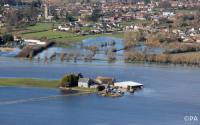-
New fabric coating could neutralize chemical weapons, save lives
Chemical weapons are nightmarish. In a millisecond, they can kill hundreds, if not thousands. But, in a new study, scientists report that they have developed a way to adhere a lightweight coating onto fabrics that is capable of neutralizing a subclass of these toxins — those that are delivered through the skin. The life-saving technique could eventually be used to protect soldiers and emergency responders.
-
-
Northrop Grumman Foundation fosters a “passion for engineering”
The Northrop Grumman Foundation and the National Science Teachers Association (NSTA) are partnering, for the second year in a row, to host twenty-five middle school teachers (fellows) from locations near Northrop Grumman sites for a year-long blended learning experience, culminating in a two-week externship during the summer at a site near them.
-
-
Preventing 3D printing hacks

Additive manufacturing (AM), also called 3D printing, is growing fast. Worldwide, the AM market grew nearly 26 percent to more than $5 billion last year, versus 2015, and another 17.4 percent this year versus last. The rapid prototyping market alone is expected to reach $5 billion by 2020. But since the global supply chain for AM requires companies to share computer aided design (CAD) files within the organization or with outside parties via email or cloud, intellectual-property thieves and malefactors have many opportunities to filch a manufacturer’s design files to produce counterfeit parts.
-
-
Replacing coal with solar will save lives, money
Tens of thousands of Americans die prematurely each year from air pollution-related diseases associated with burning coal. By transitioning to solar photovoltaics (PV) in the United States, up to 51,999 American lives would be saved at $1.1 million invested per life. To fully replace all the coal production in the United States with solar PV, it would take 755 gigawatts—a significant increase compared to the 22.7 gigawatts of solar installed in the United States currently.
-
-
Seacoast roads under new threat from rising sea level
Research has found that some roads, as far as two miles from the shore, are facing a new hazard that currently cannot be seen by drivers - rising groundwater caused by increasing ocean water levels. Without drastic improvements to these routes, at or below the pavement surface, motorists can expect segments of these roadways to deteriorate more quickly, require more maintenance and be closed for longer periods of time.
-
-
Taller wind turbine towers to help expand wind energy nationwide
Winds at higher elevations, generally, are stronger and more consistent, even in wind-rich states such as Iowa and Texas. In fact, a 20-meter increase (about 66 feet) in tower height creates a 10 percent boost in Iowa energy production. Researchers have been working on developing new concrete tower technology capable of reaching 140 meters (about 459 feet). The towers will be assembled from precast panels and columns made with high-strength or ultra-high-performance concrete. Those panels and columns can be cast in sizes that are easy to load on trucks. They are tied together on-site by cables to form hexagon-shaped cells. A crane can stack the cells to form towers as high as 140 meters.
-
-
Mass trauma’s emotional toll can disrupt children’s sense of competence
Traumatic events can have a profound effect on communities. Whether it is a terrorist attack or a natural disaster, such as a hurricane or tornado, the aftermath can have lasting effects, especially on children. How children respond in the wake of mass traumatic events is related to their perceptions of competence – or how they view their ability to control a situation. An overwhelming challenge, such as a natural disaster or a terrorist attack, can disrupt the development of that sense of well-being.
-
-
Frequency of coastal flooding will double globally in next decades

The frequency and severity of coastal flooding throughout the world will increase rapidly and eventually double in frequency over the coming decades even with only moderate amounts of sea level rise, according to a new study. The new report shows that with just 10 to 20 cm (4 to 8 inches) of sea level rise expected no later than 2050, coastal flooding will more than double. This dramatic increase in coastal flooding results from rising sea levels combined with storm-driven flooding, including the effects of waves and storm surge.
-
-
Strong carbon price needed to drive large-scale climate action: Economists
Meeting the world’s agreed climate goals in the most cost-effective way while fostering growth requires countries to set a strong carbon price, with the goal of reaching $40-$80 per ton of CO2 by 2020 and $50-100 per ton by 2030. This is the key conclusion of the High-Level Commission on Carbon Prices, led by Nobel Laureate Joseph Stiglitz and Lord Nicholas Stern. The study concludes that a well-designed carbon price is an indispensable part of a strategy for efficiently reducing greenhouse gas emissions while also fostering growth.
-
-
Middle school engineers show their skills in electric car competition
Chicago-area middle school students showcased their engineering talents of at the annual Electric Car Competition this spring. The quest: construct a fully functioning model electric car that could travel a 20-meter track while carrying a two-pound load. The task challenged students to apply the same science and engineering principles used by professional engineers every day.
-
-
Climate change likely to increase risk of costly storms in U.K.
The impact of climate change on the United Kingdom is likely to mean a higher number of more expensive wind storms, the insurance industry warned. New analysis done for the Association of British Insurers (ABI) shows temperature increases of just a small number of degrees are likely to lead to insurance losses for high winds which could be 11 percent, 23 percent, or even 25 percent higher nationwide.
-
-
Mobile phones can reveal exposure to radiation
In accidents or terror attacks which are suspected to involve radioactive substances, it can be difficult to determine whether people nearby have been exposed to radiation. But by analyzing mobile phones and other objects which come in close contact with the body, it is possible to retrieve important information on radiation exposure.
-
-
Educating, strengthening the cybersecurity workforce
As Americans become more dependent on modern technology, the demand to protect the nation’s digital infrastructure will continue to grow. CSU, designated as Centers of Academic Excellence in Information Assurance by the NSA and DHS, says that in an effort to produce career-ready cybersecurity professionals and to combat cybercrime nationwide, the California State University is creating educational opportunities for students and faculty members.
-
-
DHS S&T’s Transition to Practice program unveils 2017 cohort
Eight new cybersecurity technologies developed by researchers at federally funded laboratories and academic research centers are ready for the commercial market. DHS S&T’s Transition to Practice (TTP) program will showcase its 2017 cohort 16 May in Washington. D.C.
-
-
Right research, development investments “good bets” for both climate and economies
Investing in new ways of utility-scale electricity storage and capturing carbon to store underground should be a priority for governments aiming to meet the greenhouse gas and “green energy” targets set out in the Paris Agreement despite shrinking research and development budgets, experts suggest. Researchers analyzed a range of studies and expert reports on public energy R&D investments to uncover common threads and trends — pulling together the current state of knowledge on cost-effective investments across a range of energy technologies.
-
More headlines
The long view
Are We Ready for a ‘DeepSeek for Bioweapons’?
Anthropic’s Claude 4 is a warning sign: AI that can help build bioweapons is coming, and could be widely available soon. Steven Adler writes that we need to be prepared for the consequences: “like a freely downloadable ‘DeepSeek for bioweapons,’ available across the internet, loadable to the computer of any amateur scientist who wishes to cause mass harm. With Anthropic’s Claude Opus 4 having finally triggered this level of safety risk, the clock is now ticking.”
A Brief History of Federal Funding for Basic Science
Biomedical science in the United States is at a crossroads. For 75 years, the federal government has partnered with academic institutions, fueling discoveries that have transformed medicine and saved lives. Recent moves by the Trump administration — including funding cuts and proposed changes to how research support is allocated — now threaten this legacy.
Bookshelf: Preserving the U.S. Technological Republic
The United States since its founding has always been a technological republic, one whose place in the world has been made possible and advanced by its capacity for innovation. But our present advantage cannot be taken for granted.
Autonomous Weapon Systems: No Human-in-the-Loop Required, and Other Myths Dispelled
“The United States has a strong policy on autonomy in weapon systems that simultaneously enables their development and deployment and ensures they could be used in an effective manner, meaning the systems work as intended, with the same minimal risk of accidents or errors that all weapon systems have,” Michael Horowitz writes.
Ukraine Drone Strikes on Russian Airbase Reveal Any Country Is Vulnerable to the Same Kind of Attack
Air defense systems are built on the assumption that threats come from above and from beyond national borders. But Ukraine’s coordinated drone strike on 1 June on five airbases deep inside Russian territory exposed what happens when states are attacked from below and from within. In low-level airspace, visibility drops, responsibility fragments, and detection tools lose their edge. Drones arrive unannounced, response times lag, coordination breaks.
Shots to the Dome—Why We Can’t Model US Missile Defense on Israel’s “Iron Dome”
Starting an arms race where the costs are stacked against you at a time when debt-to-GDP is approaching an all-time high seems reckless. All in all, the idea behind Golden Dome is still quite undercooked.
